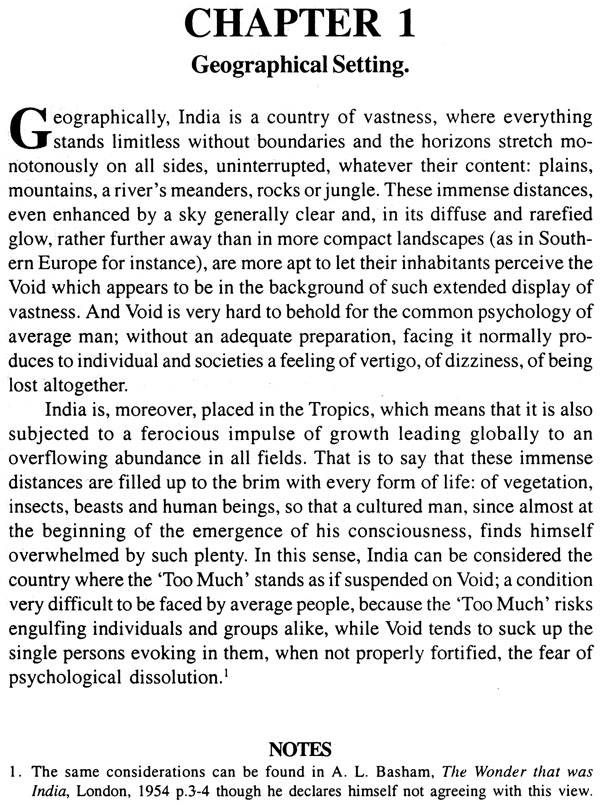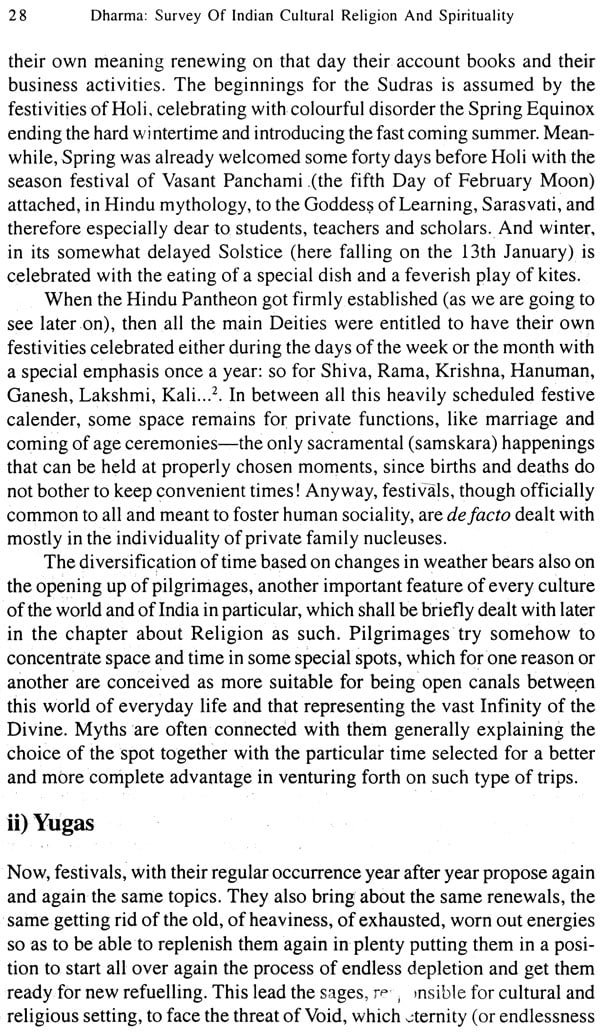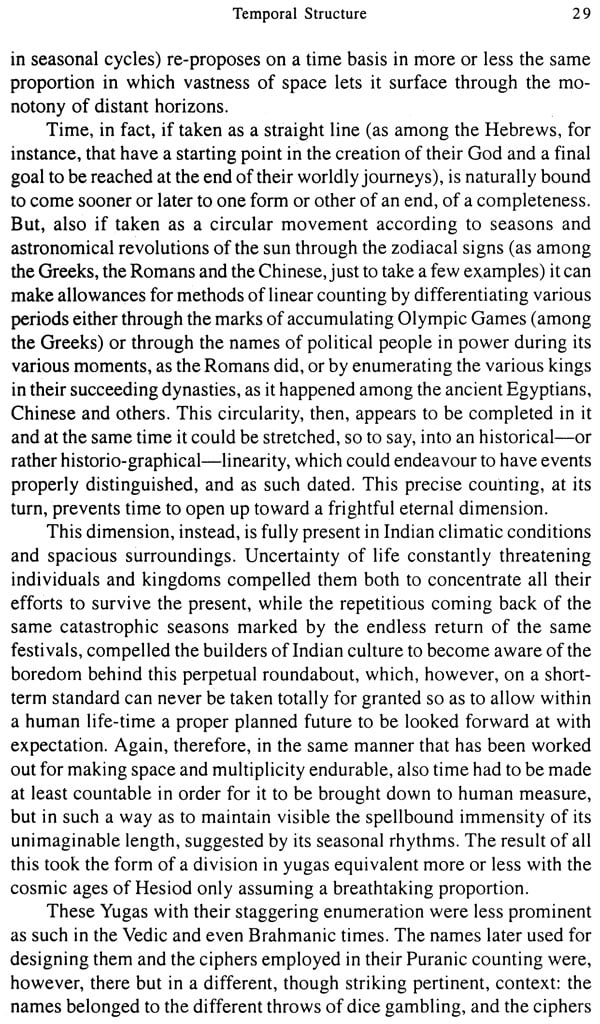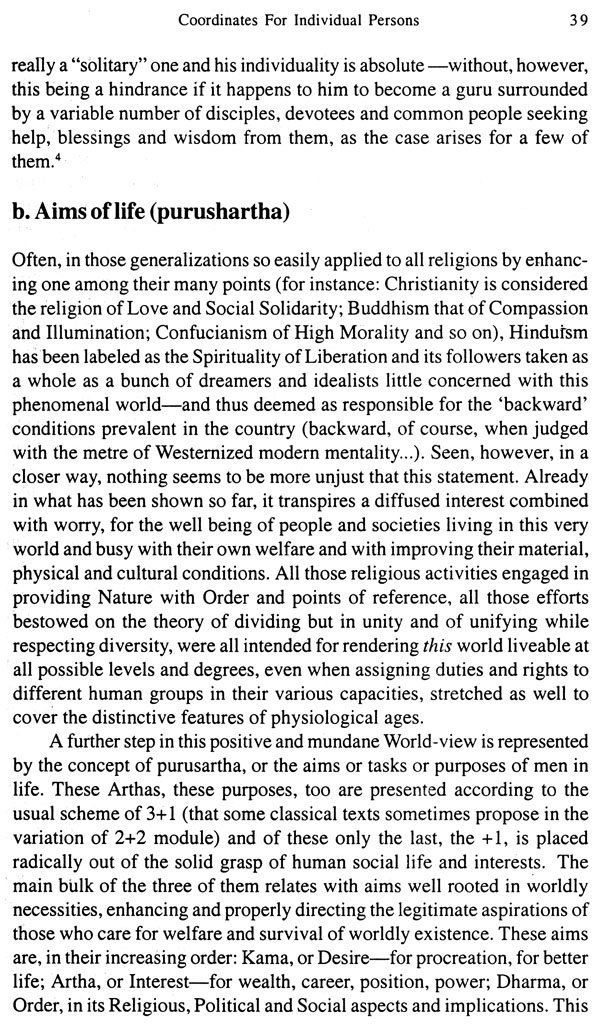
Dharma
Book Specification
| Item Code: | NAP617 |
| Author: | Uma Marina Vesci |
| Publisher: | PILGRIMS PUBLISHING,VARANASI |
| Language: | English |
| Edition: | 2005 |
| ISBN: | 8177692704 |
| Pages: | 188 |
| Cover: | Paperback |
| Other Details | 8.5 inch X 5.5 inch |
| Weight | 230 gm |
Book Description
Dharma Survey of Indian Cultural Religion and Spiritually Seen Through Brahmanic Eyes by Uma Marina Vesci is an depth study of the development of Vedic religion and spiritually in the sub-continent. The author has attempted to condense into a nutshell all the poignant features of a cultural world so disapeared in thousands or millions of rivules that it can seldoms be grasped in its totality. To this end the author has attempted with the purpose of still widening a possible field of eventual comparisions, say with other religion or spirituals has managed to compare the principles of Vedic religion with other contemporary thought of the time up to the present day.
Throughout the book author has attempted to bring into perspective the cultural and religious lifestyles of a people that is still carried on even today in varying forms. They are those forms of culture and spritualities that have grown together with the 'histories', socio-political, ritual behavious of their own 'tribes' within the boundries of a given, generally small, soceity and establish or regulate their relationship within themselves and with a Superior Power. The number of these religions, or if preferred: of local spiritualities, is virtually beyond counting since they range from earliest pre-history of mankind down to the ethnological population still alive today.
My aim in presenting a work of this vastness and magnitude is to be able to condense into a nutshell all the pointgnant features of a cultural, world which, for being so multifaious, variously articulated and,at first sight at least, so disapeared in thousands or millions of rivulets, can seldom be grapsed in its tottally. The task is full of risks, obviusly, because, in order to be able to enlarge its panorma so as to include as many items as possible, one has to enlarge its panorma so as to include as many items as possible, one has to rise higher and higher (to borrow the image from an helicopter standard) thus missing any hope of proper detail. If during the exposition from such a large scale perspective, for the sake of clarity or exemplication, some details attract more attention than others that does not mean that we alter our bird's –eye –view panorma but only that some areas in it would stick out as if pointed at by a large telescope.
The disadvantage of such a presentation is obviously the loss of depth, of the particular, with all its implications so that full justice cannot be excepted. For knowing Indian culture in depth one has to break it down into its many segmentations and pick them up, one at a time, for further studies and understanding. This is the work of monographies, a few of whose have been quoted in a neccessarily incomplete biblography. Depth cannot go together with broadness, as any execavator of wells will conform. The advantages, however, have been important enough to fouster the present attempt. Viewing everything together brings out connections that are usually missed and may lead to discover an underlying unity between all the various strata, levels idiosyncrasies and different types of kingdom, historical periods, geographical areas and socio –religious features, which taken in isolation would appear antithetical to one another. An example could be the central position in forging the religious and cultural parameters and patterns assumed by the generally neglected Brahmanas (the exegetical portion of Vedic Sacred Scriptures ). It is because of them that an almost forgotten past (the one chanted by the Ancient Rishis) has been recovered and moulded so as to suit a completly different contemporary situation in order. At its turn, to be hurled into the future.. a future still alive today after thousands of years. Or, to take another instance, one is made aware of a loose equivalences between the two major Gods of the two major Pantheons raised to promience in the popular, or exoteric, Hindu religion, yet complementary in their respective differences.
Now, with the purpose of still widening a possible field of eventual comparisions, say with other religions or spiritualities –a taks rather urgent in a modern world where people of all races and standards are thrown together by a large –scale peaceful migrations –it is not perhaps useless to preface this view of Brahmaism with a global view: that of the various religions of the world. There are almost an unlimited number of them but, if arranged in a proper historical pattern. One may be able to perceve that, they can be put into some convenient and intellgible groups, amounting in all in my opinion, to five, making comparision if not easier at least more feasible.
These five group may be presented in a very schematic manner, taking into considertion, as leading mark for the division, their socio historical situations regardless of their specific contents, which in any case, not withstanding the immense inner differentiattions, also can automatically follow into their alloted place in the pattern, though presenting wide theoretical differences in their theological contents.
The first group consists of all those religions that by scholars dealing with them have been classified as "primitive", or "pre historic" or "ethnic" or "tribal". They are those forms of culture and spiritualities that have grown together with the people responsible for them. They normally deal with the 'histories', socio –political, ritual behavious of their own 'tribes' within the boundaries of a given, generally small, society and establish or regulate their relationships within themselves and with a Superior Power. The number of these religions, or if preferred: of local spiritualities, is virtually beyond counting since they range from earliest pre-history of mankind down to the ethnological populations still alive today. Since their influence does not spread much outside the geographical limits of a single folk generally not exceeding an area of few villages inhabited by a rather small and manageable quantity of families and individuals, one can easily surmise the almost infinite quantity of them can be clustered together in so far as they share certain characterstics –such as: comparatively small and compact societies, a roughly similar conception of the Divine seen more as an indefinite Power then a personal Deity, and also a somehow homologable set of ritual and cultural behavious Since such religion are usually self- satisficient and tend to close on themselves, for a long time they remained outside the awareness of other people, so that when finally, discovered' by the inquistive minds of the Westerners, they were at first considered "primitive" or not rising above a rather simplistic side. Now, however, since more people are approaching these worlds with a more genuine desire not only to understand them in a deeper way, but also to participate in their beliefs and cultural behaviours, their great spirituals depth is getting a better recognistion at a great rate.
| Contents | Page No. |
| Introduction | 1 |
| 1. Difference in tems | 1 |
| 2. Culture as a way to control Reality | 2 |
| 3. Scheme of the work | 2 |
| Part -I | 5 |
| Chapter 1 | 7 |
| Geographical Setting | 7 |
| Chapter 2 | 8 |
| Climately | 8 |
| Chapter 3 | 9 |
| Sum up | 9 |
| Part -II | 13 |
| Coordinates As Normative Rules | 13 |
| Chapter 1 | 15 |
| The people resposible for such coordinates | 15 |
| Chapter 2 | 19 |
| Social Structure: Caste System | 19 |
| Chapter 3 | 26 |
| Temporal Structure | 26 |
| a. Cycle of seasons | 26 |
| i) Festivals | 26 |
| ii) Yugas | 28 |
| b. Sense of history | 32 |
| Chapter 4 | 35 |
| Coordinates For Individual Persons | 35 |
| a. Age of Life (Ashramas) | 36 |
| b. Aims of Life (purushartha) | 39 |
| c. Sacrments (Samskaras) | 41 |
| d. The doctrine of Debts, Rina | 45 |
| e. Conception of Death | 48 |
| f. The Law of Karma: | 52 |
| Part III | 59 |
| Religious Coordinates | 59 |
| Introduction | 61 |
| Religion of Wisdom and Popular Religion | 61 |
| Chapter I | 62 |
| Religion of Vedic Wisdom | 62 |
| a Rites: solemn and domestic | 68 |
| i) Yajna,Shrauta rites | 68 |
| ii) Domestic rites (Grhya Sutras) | 74 |
| b. The pirests and the texts: Purohitas and Vedas | 75 |
| i) The Priests | 78 |
| ii) The Texts | 79 |
| c. Shift of emphasis : interiorization and switching from knowledge | 82 |
| Chapter 2 | 92 |
| Popular religion | 92 |
| a. The texts | 93 |
| b. The Rites | 99 |
| i) Puja | 100 |
| ii)Murtis | 102 |
| iii) Mandales | 106 |
| c. The priests and the poets | 108 |
| d. Pilgrimes (Tirathayatra) | 111 |
| Chapter 3 | 116 |
| The Divine And The Deities | 116 |
| a. The Vedic Pantheon and its Impersonal Source | 116 |
| b. The Brahmanic Divinity and its children Devas and Asuras | 119 |
| c. The Epic and Puranic Deities: Vishnu and Shiva | 122 |
| i) Vishnu | 124 |
| The next two of the lists are of a different character | 127 |
| ii) Shiva | 131 |
| d. Comparisions | 135 |
| Part IV | 143 |
| Spiritual Dimensions | 143 |
| Chapter 1 | 145 |
| The domain of the individual | 145 |
| 1. Religious demand of individuals | 145 |
| Chapter 2 | 148 |
| The Three Spiritual Ways or Margas | 148 |
| a. Karma Marga | 149 |
| b. Jnana Marga or the Path of Knowledge | 151 |
| c. Bhakti Marga or the Path of Love or Devotion | 154 |
| d. Yoga | 157 |
| Chapter 3 | 160 |
| Their Ultimate Equivalence | 160 |
| Conclusions | 162 |











